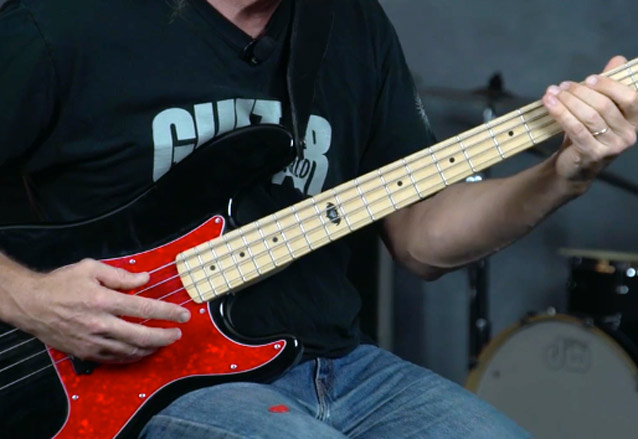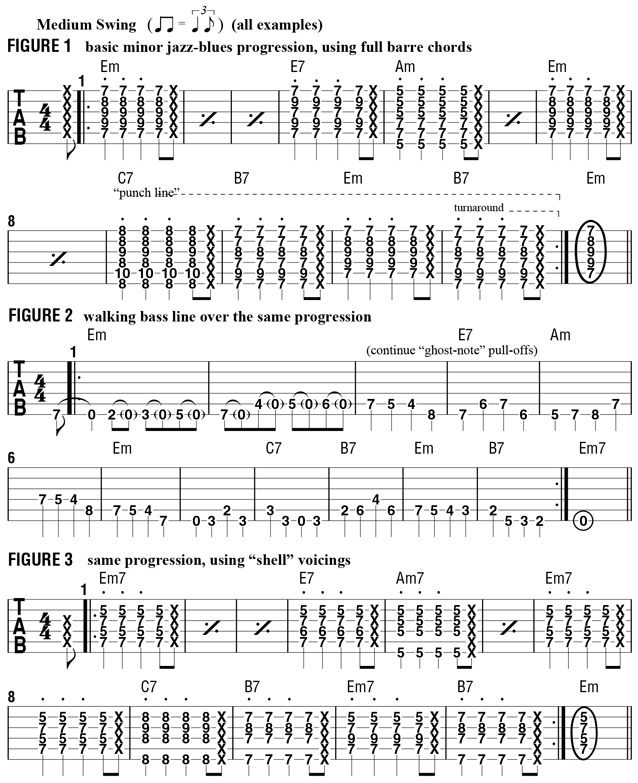The Minor Jazz-Blues Progression

A favorite progression of mine, and many jazz musicians, to solo over is what’s known as the minor jazz-blues progression, featured on such jazz classics as John Coltrane’s “Mr. PC.” and “Equinox,” “Stolen Moments” by Oliver Nelson and “Footprints” by Wayne Shorter, as well as, for those old enough to remember, the original “Spiderman Theme Song” from the late-Sixties animated TV series and, in more of a straight blues style, “The Thrill Is Gone,” made famous by B.B. King.
Led Zeppelin’s “Since I’ve Been Loving You” is a great, well-known example of a blues-rock song based on a minor blues progression that features a brilliantly original set of chord changes by Jimmy Page.
In this lesson, I’d like to focus on and introduce you to the basic structure of the minor jazz-blues progression and some of its common variations and chord substitutions, with the emphasis on accompaniment, which will serve as a harmonic foundation for some cool variations and soloing examples in upcoming lessons.
The minor jazz-blues progression is centered around minor one and four chords and is a decidedly darker, and in my opinion more dramatic-sounding, 12-bar progression than the regular, or major, jazz-blues form we’ve explored in the past half dozen lessons. It also features a different climactic “punch line” chord change in its final four bars (bars 9-12) than that customarily used in a major jazz-blues.
For comparison, using the key of E, in a straight, basic blues progression, such as, for example, that heard in Stevie Ray Vaughan’s “Pride and Joy,” the punch line is “five four one”—B7 A7 E7. In a jazz-blues, it’s “two (minor) five one”—F#m7 B7 E7. In a minor jazz-blues, it’s “six five one (minor)”—C B Em, or C7 B7 Em(7).
FIGURE 1 presents a very basic E minor jazz-blues progression, stripped down to triadic barre chords—no sevenths or other chord tones beyond the root, third and fifth. Strummed this way, with a traditional Freddie Green-, big band–style “flat four” feel, it kind of brings to mind the feel of the old Cab Calloway song “Minnie the Moocher” that was prominently featured in the 1980 film The Blues Brothers, although that song is slower and is based on a somewhat different chord progression in the same key.
It also has a sort of gypsy jazz flavor, like many songs recorded by the legendary jazz guitarist Django Reinhardt back in the Thirties and Forties. Note the use of the E major chord in bar 4, which serves to create a stronger “push” toward the Am chord in bar 5 than staying on Em would. This is called the “five of four” (the five chord of the four chord).
FIGURE 2 is a sample walking bass line built around the same chord progression and demonstrates how to use arpeggios, scales tones and chromatic passing tones to craft a smoothly strutting line over this set of chord changes. As we’ve seen previously, notice the use of “ghost-ed” eighth-note pull-offs to the open strings in the first two bars. This technique may be applied to the remaining quarter notes to give the line a nice, swinging “bounce.”
FIGURE 3 incorporates sparse, seventh-chord “shell” voicings into our basic minor jazz-blues progression, which give it a more modern jazz flavor, albeit with the traditional flat-four strum pattern still maintained for purposes of illustration and comparison. Try jamming on and soloing over both sets of chords and the walking bass line (with the help of a friend or digital recording device). Next time, we’ll look at some more modern and “hipper” ways to play and vary the minor jazz-blues progression.

Get The Pick Newsletter
All the latest guitar news, interviews, lessons, reviews, deals and more, direct to your inbox!
Over the past 30 years, Jimmy Brown has built a reputation as one of the world's finest music educators, through his work as a transcriber and Senior Music Editor for Guitar World magazine and Lessons Editor for its sister publication, Guitar Player. In addition to these roles, Jimmy is also a busy working musician, performing regularly in the greater New York City area. Jimmy earned a Bachelor of Music degree in Jazz Studies and Performance and Music Management from William Paterson University in 1989. He is also an experienced private guitar teacher and an accomplished writer.
“There are so many sounds to be discovered when you get away from using a pick”: Jared James Nichols shows you how to add “snap, crackle and pop” to your playing with banjo rolls and string snaps
Don't let chord inversions bamboozle you. It's simply the case of shuffling the notes around









![Joe Bonamassa [left] wears a deep blue suit and polka-dotted shirt and plays his green refin Strat; the late Irish blues legend Rory Gallagher [right] screams and inflicts some punishment on his heavily worn number one Stratocaster.](https://cdn.mos.cms.futurecdn.net/cw28h7UBcTVfTLs7p7eiLe.jpg)


